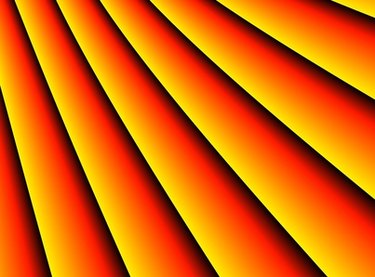Things You'll Need
Fabric
Tape measure
Pins
Iron
Ironing board
Seam gauge

Knife pleats are named for their sharp edges. They add fullness without bulk especially when they are stitched down at the top. Stitched-down knife pleats make the classic kilt flattering and easy to wear. In home decor, knife pleats are a tailored way to add interest to pillows and draperies. You can use inserts of tiny knife pleats to decorate accent pillows or add a knife-pleated skirt to a slipcover to create a dramatic but tailored dinning room chair.
Using a printed paper pattern that includes knife pleats
Step 1
Cut your fabric so the pleats will fall on the grain of the fabric. The "grain" of the fabric is the lines of the threads in the fabric. If you are using a printed paper pattern the pleats will be drawn along the grain line marked on the pattern. All you have to do is be sure you are cutting the pattern piece "on the grain" by measuring from the grain line marked on the pattern to the selvage, or tightly woven edge of the fabric. Be sure this measurement is the same at both ends of the arrow that marks the grain line.
Video of the Day
Step 2
Transfer the pleat lines marked on the pattern to the fabric piece with tracing paper and a tracing wheel; you also can use pins or a fabric marker. If you are not planning to wash the garment, only use the tracing wheel at the top and bottom of the pleat.
Step 3
Place the fabric on an ironing board and fold it along the first fold line. Pin this fold and press it in.
Step 4
Fold the back layer of fabric out along the next fold line. Pin this fold in place and press it in. This forms your first knife pleat.
Step 5
Fold and press the rest of the pleats.
Step 6
Baste the pleats down at the top and bottom
Adding knife pleats to a pattern
Step 1
Pleat the fabric before you cut out the pattern piece. This is the easiest way to add pleats to a garment you are constructing.
Step 2
Cut a strip of fabric the "height" of your pattern piece and at least three times as long as the width of the pattern piece across the row of pleats. The height is the dimension parallel to the pleats and the width is the dimension perpendicular to the pleats. Be sure to cut this rectangle of cloth square to the grain of the fabric by cutting perpendicular to the selvage edges.
Step 3
Fold the fabric with wrong sides together to form the edge of the pleat. Be sure the fold is equidistant from the fabric edge at the top and bottom of the fold.
Step 4
Press the fold flat.
Step 5
Set your seam gauge to the depth you want your pleat to be. Lay the folded fabric on your ironing board with the fold at the top and pull the bottom layer out leaving a small fold or pocket of fabric folded back under the top layer of fabric. Insert your seam gauge into the "pocket" and be sure it is the desired depth all along the fold.
Step 6
Iron this pleat in. This is a knife pleat.
Step 7
Continue making evenly spaced knife pleats until the panel of pleats reaches the width you desire. Be sure the pleats are not so deep they overlap on either side of the fabric.
Step 8
Pin your fabric to the pleated panel with the pleats running parallel to the grain line.
Step 9
Cut out your pattern piece.
Step 10
Baste the pleats down at the top and bottom.
Step 11
FInish constructing your garment.
Tip
Beautiful pleats are evenly spaced, all the same depth and exactly parallel to each other. Set your pleats by pressing them on the highest temperature and with the most steam your fabric can stand. Use a pressing cloth with delicate fabrics.
Video of the Day